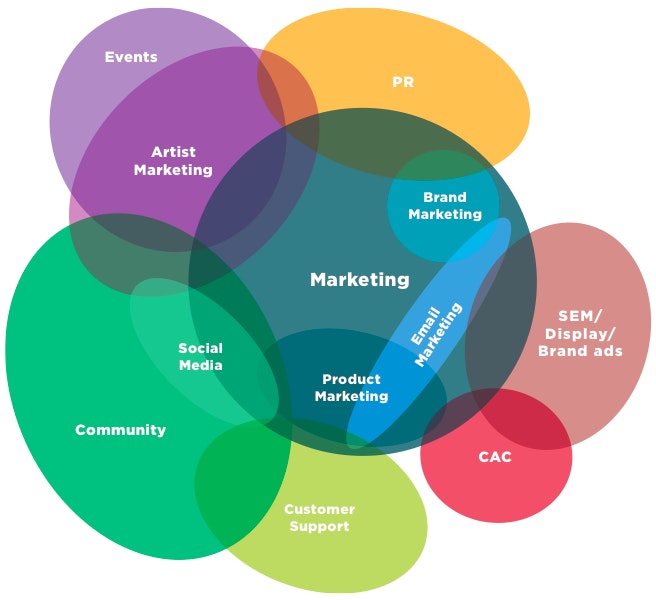Traditionally, marketing and customer service teams have little — if anything — to do with one another.
Once the marketing team has brought in a new customer, they hand them off to support and begin focusing on the next lead. Whatever happens with the customer after the “handoff,” good or bad, is none of their concern.
Of course, there are a number of problems with this mentality.
Key reasons to ‘de-silo’ your marketing and customer service teams
Lack of alignment between teams can cause friction in terms of the customer’s expectations, leading to frustration and disappointment. For example, if a company’s marketing team promotes the idea that the company provides x, y, and z services — but the support team only offers x _and _y — its customers will understandably be let down.
Additionally, teams that don’t communicate with each other run the risk of bothering and annoying their customers by reaching out multiple times for the same reason. Say a soon-to-be customer explains their problem to a company’s marketing team and decides to become a paying customer, only to be contacted by the support team and asked to explain their problem again. Not only will this lead to frustration on the customer’s end, it wastes time for everyone involved.
Lastly, unaligned teams lack the ability to identify and track optimum prospects as well as customers who have the potential to become brand advocates. Customer service teams need to communicate back to the marketing team with information regarding which customer segments to target through future initiatives.

Why marketing and customer service teams need to work together
Providing a streamlined, enjoyable experience to your customers is essential. Consumers don’t merely appreciate positive experiences — they expect them. By 2020, customer experience (CX) will be — surpassing the actual quality of the product or service being provided.
Positive customer experiences improve customers’ likelihood to return to a specific brand and increase the probability they’ll spend more. A positive experience improves the customer’s overall satisfaction with the brand in question.

On the other hand, providing a poor experience to your customers can be incredibly detrimental to your business.
The first step in ensuring your customers have a positive end-to-end experience with your brand is to shift your internal structures to enable your marketing and customer service teams to communicate and collaborate more effectively.
Once your marketing and customer service teams do start working together, your organization will almost automatically begin seeing improvements across the board.
For one thing, creating fleshed-out customer personas becomes much easier. Instead of just considering who your prospective customers are before they engage with your brand, you’ll now have information to help you illustrate what your product or service can help them become (based on how you’ve helped similar customers in the past).
You’ll also be able to set realistic goals for your soon-to-be customers regarding the value your products or services will provide them. Sans alignment, your marketing team may inadvertently promise things your service teams might not be able to provide. De-siloing your company’s teams all but eliminates the chances of this happening.
Aligning your teams ensures all involved parties stay in the loop regarding individual customers’ experiences with the organization. Both marketing and support teams will know what’s already been discussed with a given customer, as well as what the customer expects to happen next. Not only does this result in less repetition and back-and-forth, it also ensures no steps are skipped during the process of onboarding and providing service to your customers.
How to incorporate customer service into your marketing initiatives
Forging a cohesive relationship between your marketing and customer service teams requires a shift in mindset and philosophy among all members of your organization.
While this shift might sound easier said than done, it certainly can be accomplished when approached strategically and methodically. Through this strategic approach, you’ll inherently strengthen your marketing mix — in turn enhancing your organization’s ability to meet your customers’ needs.
Take these steps to facilitate this mindset shift within your organization and ensure your marketing and customer service teams remain aligned ad infinitum.
1. Explain and encourage the shift
Perhaps the most important step in the process of de-siloing your marketing and customer service teams is to ensure everyone understands why you’re doing so in the first place.
Communicate the benefits of forging a cohesive relationship between teams, both in philosophical and concrete terms. You want to extol the virtues of an integrated organization and provide real-world examples of how other companies have successfully made this fundamental shift in operations.
After getting your team on board with the shift, you’ll need to provide guidance as they begin to implement changes.
2. Enable and encourage meaningful communication
It’s not enough for your marketing and customer service teams to open a line of communication with each other — both sides need to ensure the other understands the meaning and importance of the message being communicated as well.
The process of creating and developing personas needs to be a shared activity between marketing and customer service teams. Help Scout’s Mat Patterson explains:
“When you have a particular idea of who your customer is but the person you’re talking to has a completely different idea, it’s very hard to have a productive conversation. But if you’re both talking about “Mary the Marketing Manager,” you can advocate for Mary’s interests instead of arguing about your personal preferences, making Mary (your customer) the framework for decision making.”
Mat suggests scheduling meetings and training sessions that involve — and solicit input from — both marketing and service teams. During these sessions, members of each team can pick each others’ brains to learn more about which strategies are (or aren’t) working and gain insight into why this might be.
3. Share responsibility and success
Picture a marketing team hopelessly watching their precious leads defect due to poor customer service, or a customer service team standing idly by waiting for the marketing team to bring in customers.
Infighting can occur when one team lives up to the customers’ expectations but the other does not, and the ensuing “blame game” accomplishes nothing. And even when both teams are successful in serving a given customer, it’s still likely the customer’s overall experience wasn’t as streamlined and seamless as it could have been.
Another negative byproduct of siloed teams is that either one can quickly become complacent if the other seemingly isn’t pulling their weight. The team that feels slighted will stop caring about whether or not they accomplish their goals at all.
To encourage your marketing and service teams to both take ownership of the customer’s overall experience with your organization, make sure both teams understand they’re responsible for quantitative metrics such as:
Complaint-to-Resolution rate (and average Time to Resolution)
Engagements per complaint/submission
Customer survey data (Customer Satisfaction Score, Customer Effort Score, Net Promoter Score)
You’ll also want to collect and assess any qualitative data your customers provide with regard to their experiences with your organization. That information will help both teams identify areas in need of improvement, and it will enable them to collaborate to make improvements.
The goal when looking at this data as a cohesive team is not to place blame (e.g., to say it’s the marketing team’s fault that your conversion rate is so low). Rather, the goal is for each team to look at these metrics and figure out what they can do to help the other team succeed in their respective endeavors.
By encouraging both parties to take full responsibility for the entire customer experience, you’ll empower both teams to go above and beyond their “normal” duties in the name of helping their customers succeed.




